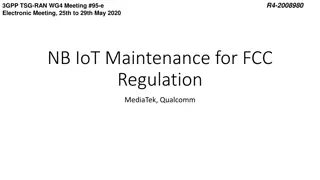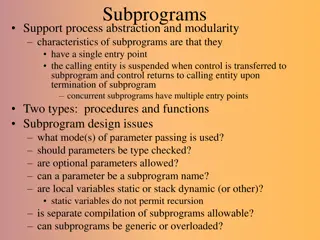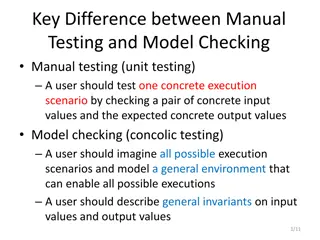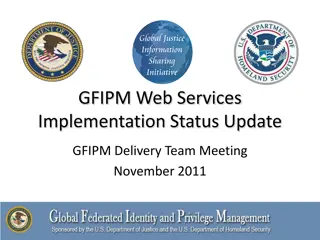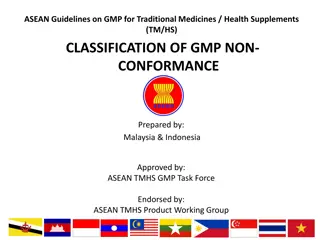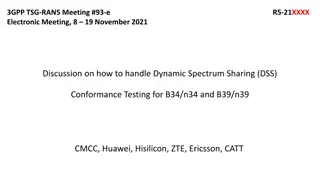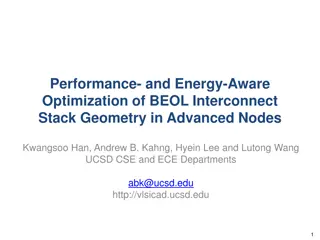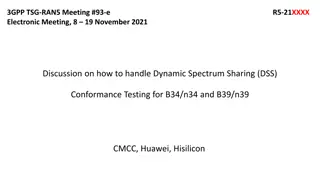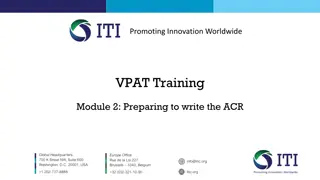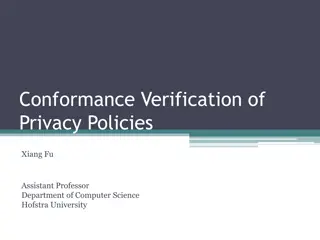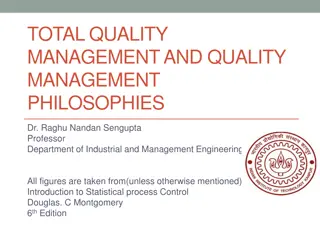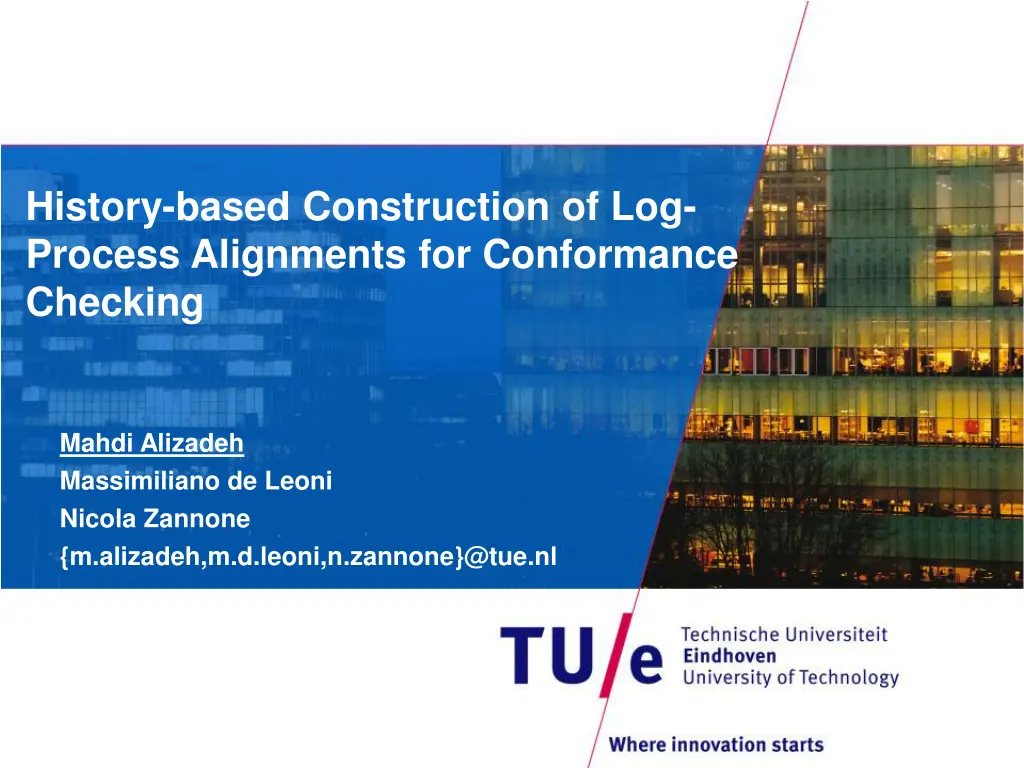
Advanced Techniques for Conformance Checking in Process Analysis
Explore the innovative methods for aligning logs and processes, evaluating non-conformity, defining cost functions, and enhancing historical awareness in process analysis. Discover how automated tools can help optimize alignment and improve decision-making in analyzing process executions.
Download Presentation

Please find below an Image/Link to download the presentation.
The content on the website is provided AS IS for your information and personal use only. It may not be sold, licensed, or shared on other websites without obtaining consent from the author. If you encounter any issues during the download, it is possible that the publisher has removed the file from their server.
You are allowed to download the files provided on this website for personal or commercial use, subject to the condition that they are used lawfully. All files are the property of their respective owners.
The content on the website is provided AS IS for your information and personal use only. It may not be sold, licensed, or shared on other websites without obtaining consent from the author.
E N D
Presentation Transcript
History-based Construction of Log- Process Alignments for Conformance Checking Mahdi Alizadeh Massimiliano de Leoni Nicola Zannone {m.alizadeh,m.d.leoni,n.zannone}@tue.nl
Agenda History-Aware Conformance Checking Alignment Evaluation Future Works Department of Mathematics and Computer Science 28-05-2014 PAGE 1
History-Aware Conformance Checking Alignment Evaluation Future Works Department of Mathematics and Computer Science 28-05-2014 PAGE 2
Alignment Identifying nonconformity between a trace and model Each trace has several alignments Cost function Optimal alignment Department of Mathematics and Computer Science 28-05-2014 PAGE 3
Cost functions Two types of cost functions Computing an optimal alignment Measuring the severity of deviations Existing approaches for defining a cost function: Background knowledge of process analysts Not trivial and time-consuming Based on the human judgment Standard cost function Department of Mathematics and Computer Science 28-05-2014 PAGE 4
Standard Cost Function Penalizes every deviation equally Not realistic B E Trace: A D C D A 5% Trace A >> Net D D Simplest explanation for non-conformity A C Trace Net A A >> B >> E D D The most probable explanation for non-conformity Department of Mathematics and Computer Science 28-05-2014 PAGE 5
History-Aware Conformance Checking Alignment Evaluation Future Works Department of Mathematics and Computer Science 28-05-2014 PAGE 6
History-aware cost function Challenge: Use objective factors Automatically compute the cost of movements Find the most probable explanation of non-conformity Solution: Analyzing past process executions to define the cost function Activity Names Time Data attributes Resource . Control Flow Department of Mathematics and Computer Science 28-05-2014 PAGE 7
Computing the Cost of an Alignment Move R I4 I3 I I1 V S O I5 C I2 2 A 1: C V S R V O (O, >>) (>>,S) (>>,A) . State of the system Cost Profile Function Trace Net C C V V S S >> I3 R R V V Computing Probabilities Cost of alignment moves State Representation Function Department of Mathematics and Computer Science 28-05-2014 PAGE 8
Step-1: State Representation Function Different functions can be used to characterize the state of the system Abstraction Type Order of activity # of occurrences of activities occurrences of activities Sequence Multi-set Set Based on the function, different traces can be mapped onto the same state {C,V,S,R} Set 1= CVSRVSR {C,V,S,R} {C(1), V(2), S(2), R(2)} {C(1), V(2), S(1), R(1)} Example: 2= CVSRV Department of Mathematics and Computer Science 28-05-2014 PAGE 9
Step-2: Probability of Different Alignment Moves Move on model (>>, a) We expected to see an activity a in the next step Probability that an activity occurs after reaching certain state Move on Log (a, >>) Unexpected activity was executed Probability that an activity never eventually occurs after reaching certain state Trace # C V S R V S I O C V S R V S I C V S R V A I O C V S R V A I 700 200 10 90 Move on model 900 1000 100 1000 p = = 0.9 (>>, S) State1: C V S R V p = = 0.1 (S, >>) Move on log Department of Mathematics and Computer Science 28-05-2014 PAGE 10
Step-3: Cost Profile Cost Profiles f1(p)=1/p f2(p)=1+log(1/p) Move on model f1(p) = 1.11 f2(p) = 1.04 f1(p) = 10 f2(p) = 2 p = 0.9 (>>, S) State: C V S R V p = 0.1 (S, >>) Move on log f1(p) penalizes less probable moves much more than f2(p) Department of Mathematics and Computer Science 28-05-2014 PAGE 11
Discussion: Cost Profile The selection of the cost profile has a significant impact on the results Which alignment should be considered as an optimal alignment? f1(p)=1/p 1: X Y A50 A1 99% Y X 1% f2(p)=1+log(1/p) B Tradeoff: Frequency of the traces in historical logging data Number of deviations in alignments Department of Mathematics and Computer Science 28-05-2014 PAGE 12
History-Aware Conformance Checking Alignment Evaluation Future Works Department of Mathematics and Computer Science 28-05-2014 PAGE 13
ProM Plugin Department of Mathematics and Computer Science 28-05-2014 PAGE 14
Experiments Synthetic Data Real-life logs Process Model ProM Plugin 80% Add or remove activities Most probable alignment Perfectly fit traces with model 20% Original Trace: CVAIO Reconstructed Trace: CVSIO Trace: CVIO A is removed Measuring quality of the alignments: 1. Percentage of Correct Alignment (CA) 2. Levenshtein Distance (LD) Alignment technique when standard cost function is used Different amounts of noise: 10%, 20%, 30%, 40% State representation function: Sequence, Multi-set, Set Cost profiles: 1 2 1 ( ) , f p f p = 1 1 p = + ( ) , ( ) 1 log( ) p f p 3 p Department of Mathematics and Computer Science 28-05-2014 PAGE 15
Synthetic Data: Loan Process Management The type of cost profile The type of state representation Different level of noise Percentage of Correct Alignments (CA): +4.2% Levenshtein Distance (LD): +15.2% Department of Mathematics and Computer Science 28-05-2014 PAGE 16
Real-life Logs: Traffic Fine Management Process Percentage of Correct Alignments (CA): +1.8% Levenshtein Distance (LD): +21.1% Department of Mathematics and Computer Science 28-05-2014 PAGE 17
History-Aware Conformance Checking Alignment Evaluation Future Works Department of Mathematics and Computer Science 28-05-2014 PAGE 18
Future Works History-aware conformance checking Cost-profile function Considering other business process perspectives (e.g. data, context, resources) Severity Cost function (quantification of deviations) Department of Mathematics and Computer Science 28-05-2014 PAGE 19
Thanks for your attention. Department of Mathematics and Computer Science 28-05-2014 PAGE 20




